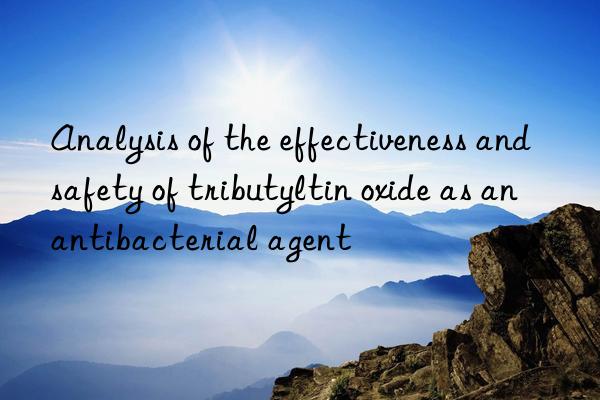
Introduction
With the increase in antibiotic resistance, the search for new antibacterial agents has become one of the focuses of the global scientific community. Organometallic compounds have shown potential in the antimicrobial field due to their unique chemical properties. Among them, tributyltin oxide (TBT), as a tin-containing organic compound, has attracted attention due to its broad antibacterial activity. This article aims to explore the effectiveness of tributyltin oxide as an antibacterial agent and its potential safety issues.
1. Basic characteristics of tributyltin oxide
Tributyltin oxide (C12H27SnO) is an organometallic compound with a molecular weight of approximately 289.67 g/mol. It is usually in a colorless to light yellow liquid state, has good solubility, and can be dissolved in a variety of organic solvents. TBT is known for its bioaccumulation in certain environments, particularly marine environments, where its toxicity has caused widespread concern.
The antibacterial mechanism of di- and tributyltin oxide
The effectiveness of TBT as an antibacterial agent is mainly attributed to its effect on microbial cell membrane and cell wall structure. Specifically, TBT can exert its antibacterial effect through the following mechanisms:
Destroy the integrity of the cell membrane: TBT can be inserted into the bacterial cell membrane, interfering with the normal function of the membrane, causing the leakage of intracellular substances and causing cell death.
Inhibit enzyme activity: TBT can bind to key enzymes in cells and inhibit enzyme activity, thus hindering the metabolic process of microorganisms.
Induces oxidative stress: TBT can trigger oxidative stress in cells, producing excess free radicals and damaging DNA and other cellular components.
3. Antibacterial spectrum of tributyltin oxide
Research shows that TBT has broad-spectrum antibacterial effects against a variety of pathogenic bacteria. It is not only effective against Gram-positive bacteria (such as Staphylococcus aureus), but also shows antibacterial activity against Gram-negative bacteria (such as Escherichia coli). In addition, TBT can also fight fungi and some viruses, making it a potential multi-purpose antibacterial agent.
4. Security Considerations
Although TBT has demonstrated strong antibacterial ability under laboratory conditions, its safety issues cannot be ignored. TBT has been proven to be ecotoxic and bioaccumulative, especially in aquatic ecosystems, and may cause serious harm to fish and other aquatic organisms.
Ecotoxicity: TBT can enter the food chain through bioaccumulation and have a negative impact on the reproductive capacity, growth and development of aquatic organisms.
Human health risks: Although TBT is mainly used for preservative and antifouling treatments of non-edible products, its potential human health risks still need to be evaluated. Exposure to TBT may cause skin irritation or other allergic reactions.
Environmental residues: TBT is not easily degraded, and its residues may exist in the environment for a long time, causing pollution to soil and water bodies.
5. Substitutes and future directions
In view of the environmental and health risks of TBT, many countries and regions have restricted or banned its use in certain areas. Researchers are exploring other safer and more environmentally friendly antibacterial agents as alternatives to TBT, such as silver nanoparticles, copper ion complexes, etc.
6. Conclusion
Tributyltin oxide, as an effective antibacterial agent, has shown broad application prospects in laboratory studies. However, given its potential threats to the environment and human health, its use must be strictly regulated and research into safer alternatives continues. Future antimicrobial agent development should focus on balancing antimicrobial efficacy with ecological safety to ensure that the compounds used are both effective against pathogens and reduce adverse effects on the environment and public health.
Extended reading:
Tetrachloroethylene Perchloroethylene CAS:127-18-4
Toyocat TE tertiary amine catalyst Tosoh
Toyocat RX5 catalyst trimethylhydroxyethyl ethylenediamine Tosoh

 微信扫一扫打赏
微信扫一扫打赏

